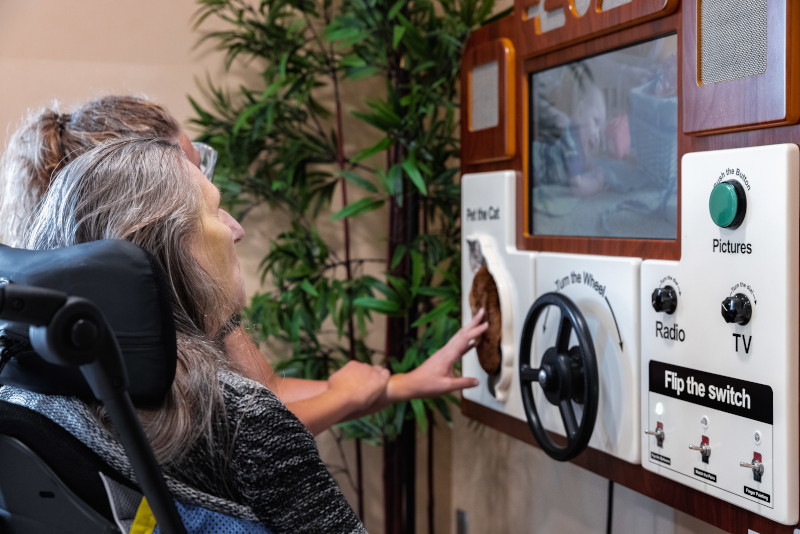Salem Home
Feel the compassion
Business View North America interviews Sherry Janzen, CEO of Salem Home, for our focus on Long-Term Care in North America
For residents of Salem Home, an aged care facility in Winkler, Manitoba, life is filled with friendly faces, and all the comforts of home. With a vision statement that says, “Salem Home will be recognized as an innovative leader in the delivery of Long Term Care,” employees of the facility strive to provide relationship-centered care while delivering a diverse selection of experiences to keep residents comfortable and engaged. The 146-bed facility employs more than 300 people, many of whom have been with Salem Home for years.
Founded in 1998 by the Mennonite churches of Winkler and surrounding areas, the Salem Foundation provides funding for Salem Home projects that are not funded through the provincial government. Through fundraising and community relationships, the Foundation has been able to continuously impact the lives of those living at the home. Sherry Janzen, Salem Home CEO, shares, “We had one local business celebrate their 50th anniversary by building a dining room for one of the care areas. We have changed the front entrance to automatic doors, making it user friendly, which was community funded as well. We have added the Abby Board – a giant interactive computer that looks like a radio, but comes with a steering wheel. When you touch the steering wheel, the car begins to drive along a country road, or to the beach. Two of the Care Areas have these and the Ladies Auxiliary is going to be working on the third one.”
Identifying the needs of the residents is done through observation and evaluation of the environment and how they interact with it, using the QUIS-EH-O Evaluation Instrument. Janzen reports, “We had a storage room across from one of the care stations. The residents love to congregate where people are because that’s what residents living with dementia do; they like to be together with people. So, we knocked out the storage room and created a little sitting room. We are constantly doing things like that in our building as a result of what the evaluation shows us.”
With a waitlist of 30, Salem Home was unable to admit anyone during the initial COVID-19 lockdown. For this reason, the facility eventually ended up with 20 empty beds. That led to a board decision to begin a multi-million dollar renovation to update the 60-bed Cottonwood Unit built in 1972. A three-phase project, each phase will update 20 beds, remove asbestos, add air conditioning, new furniture, draperies, high quality electric beds, and updated lifting systems. Fire suppression, a new air handling system, and the inclusion of air conditioning to the resident rooms is also part of the project, along with innovative navigation tools to assist those living with dementia.

Ninety-three percent of Salem Home residents have dementia, something which can be challenging for everyone involved. Behaviors such as aggression, refusal of care, and wandering are just some of the issues that can arise from those struggling with dementia. Janzen recalls, “In 2018, it really peaked, when 78 percent of those residents had behaviors. We became very diligent about introducing technology and education to staff to start mitigating some of that. We introduced ‘Dementiability’ into our building in 2016, but in the last four years we have become much more purposeful. Dementiability is the Montessori way for dealing with dementia. We find things that give residents meaning and purpose. If they are engaged in activities, they will not demonstrate their behavior.”
As the only care home in the province of Manitoba with a behavioral treatment unit, Salem Home offers short-term stay for residents who are unable to adjust to a personal care home. With an average daily medication cost of $1.74 per resident, medication is a last resort. Staff are trained in CARES, a training program which focuses on person-centered care, providing insight into the changes in cognitive skills as dementia progresses, and how to understand this in terms of behavior.
With this approach to dementia care, it was found that there was a gradual decrease in behaviors. In 2019 out of the 93 percent of residents that had dementia only 37 percent were exhibiting behaviors. A further decrease to 33 percent was noted in 2020, which was interesting due to the drastic changes brought on by the pandemic. “We have already had conversations about what we want things to look like when we come out of this,” says Janzen. “Maybe, what we are doing is setting the residents up to have behaviors by thinking that the more activities there are in the building the better off the resident is. So, we are going to be more deliberate in what we do, and when families are allowed, or the public is allowed into our building.”
Throughout the pandemic, the facility has followed strict visitation protocols, whether under full or partial lockdown conditions. Karin Oliveira, Director of Residential Care Services, explains, “We say partial because we are allowing people in, like the designated family caregivers, and when we have end-of-life care, then we allow extra general visitors in, as well. Sometimes people have that idea that nobody was coming in and that the residents are abandoned or alone, and they’re not. We tried to maintain their socialization as much as possible. We continued to have activities. We just changed the way we do the activities. Instead of having large group activities, we’re doing the smaller groups in the care area, so the residents are not mixing with other residents in the building.”
Supporting staff during the stress and anxiety of COVID has been a priority at Salem Home, where everyone is working tirelessly to care for and protect the residents. Oliveira reports, “We tried to have more opportunities for staff to talk with their direct supervisors, or the social worker. Our Pastoral Coordinator does go around the building and has small devotions with the staff. We have different relaxing activities that we offer for staff to do during breaks if they want a distraction. We sent a survey out to ask what they would be interested in, they responded, and we built on that.” With three physicians regularly visiting Salem Home, employees were also able to meet with them to discuss questions and concerns, which was another helpful resource.

Keeping staff informed of constantly changing public health orders was a challenge which was met with perseverance. According to Janzen, “The public health orders were changing every day. Once we had it figured out and we had clarification, we would have town halls for the staff, so they knew what was going on and what Salem was doing about it.” Empathizing and understanding what employees might be feeling, especially as directions changed, was ongoing. “I can only imagine what the staff are feeling because they are in the front lines. So, we meet with them, and we talk about that so that they know that it’s scary for us, too. I don’t think we ever shied away from saying, ‘we feel the same way you do, but we just have to work through this’,” Janzen adds.
In the early days of the pandemic, Salem Home implemented an emergency response group using WhatsApp as a communication tool. “Everybody was on that group that needed to be,” says Janzen, “so, if something happened in the building, we could actually make a decision on the spot whenever we needed to. We could respond to the staff almost immediately.” When the facility had an outbreak, resident care managers stepped up to help, making sure there was a manager working everyday, staying late so staff were not alone. Acting as runners, management would also take time to do other jobs, like folding gowns, delivering samples to the hospital, and anything else they could do to assist.
“It took away some of the stress for them because I can’t imagine if the nurses had to deal with all of that and look after the residents, which would not have been pretty,” says Oliveira. “That was our way to help, and the nurses knew that we would be here, so that gave them peace and confidence. They could do their work. They didn’t have to stress about the extra responsibilities.”
Moving forward, Salem Home has a plan to add behavioral support and care environment beds, a long-term option for residents that come from the behavior treatment unit but are unable to adjust to a regular nursing home. As for the future of Salem Home, Janzen sees a continuation of the positive care and attention the home is known for. She shares, “As soon as people walk into our building, they feel a difference. My dad once said to me, ‘I feel safe when I walk into this building’. That’s a good feeling to have, because you want to put your loved one into a place where you can trust staff to take care of them. When I look around the leadership table there is a lot of creativity, a lot of innovation, a lot of passion for what each one of them is responsible for, and for Salem Home as a whole. That translates into the rest of the building.”
AT A GLANCE
Salem Home
What: An innovative, 146 bed aged-care facility
Where: Winkler, Manitoba, Canada
Website: www.salemhome.ca
PREFERRED VENDORS
National Industrial Communications Inc. – nici.mb.ca
NICI is an industry leader in providing our customers in Health Care Facilities with practical solutions that offer proven operability, and verified functionality. Our offering includes Nurse Call, Wandering Patient, CCTV, Access Control, Public Address, Intercom, and Digital Signage Systems. Design, Budgeting, Sales, Support and Service all from one Source.




